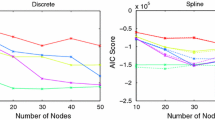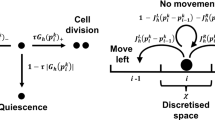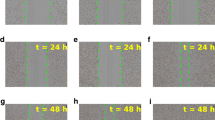Abstract
Reaction-diffusion equations have been used to model a wide range of biological phenomenon related to population spread and proliferation from ecology to cancer. It is commonly assumed that individuals in a population have homogeneous diffusion and growth rates; however, this assumption can be inaccurate when the population is intrinsically divided into many distinct subpopulations that compete with each other. In previous work, the task of inferring the degree of phenotypic heterogeneity between subpopulations from total population density has been performed within a framework that combines parameter distribution estimation with reaction-diffusion models. Here, we extend this approach so that it is compatible with reaction-diffusion models that include competition between subpopulations. We use a reaction-diffusion model of glioblastoma multiforme, an aggressive type of brain cancer, to test our approach on simulated data that are similar to measurements that could be collected in practice. We use Prokhorov metric framework and convert the reaction-diffusion model to a random differential equation model to estimate joint distributions of diffusion and growth rates among heterogeneous subpopulations. We then compare the new random differential equation model performance against other partial differential equation models’ performance. We find that the random differential equation is more capable at predicting the cell density compared to other models while being more time efficient. Finally, we use k-means clustering to predict the number of subpopulations based on the recovered distributions.







Similar content being viewed by others
Data Availability Statement
The code and data are publicly available at: https://github.com/kcnguyen3191/rande_prmf
References
Adoteye K, Banks HT, Flores KB (2015) Optimal design of non-equilibrium experiments for genetic network interrogation. Appl Math Lett 40:84–89. https://doi.org/10.1016/j.aml.2014.09.013
Akaike H (1974) A new look at the statistical model identification. IEEE Trans Autom Control 19(6):716–723. https://doi.org/10.1109/TAC.1974.1100705
Baldock AL, Ahn S, Rockne R, Johnston S, Neal M, Corwin D, Clark-Swanson K, Sterin G, Trister AD, Malone H, Ebiana V, Sonabend AM, Mrugala M, Rockhill JK, Silbergeld DL, Lai A, Cloughesy T, McKhann GM, Bruce JN, Rostomily RC, Canoll P, Swanson KR (2014) Patient-specific metrics of invasiveness reveal significant prognostic benefit of resection in a predictable subset of gliomas. PLoS ONE 9(10):99057. https://doi.org/10.1371/journal.pone.0099057
Banks HT, Davis JL (2007) Quantifying uncertainty in the estimation of probability distributions with confidence bands. Technical report, Center for Research in Scientific Computation, North Carolina State University. https://repository.lib.ncsu.edu/bitstream/handle/1840.4/1386/crsc-tr07-21.pdf
Banks HT (2012) A functional analysis framework for modeling, estimation, and control in science and engineering. CRC Press, Boca Raton
Banks HT, Davis JL (2007) A comparison of approximation methods for the estimation of probability distributions on parameters. Appl Numer Math 57(5–7):753–777. https://doi.org/10.1016/j.apnum.2006.07.016
Banks HT, Joyner ML (2017) AIC under the framework of least squares estimation. Appl Math Lett 74:33–45. https://doi.org/10.1016/j.aml.2017.05.005
Banks HT, Kareiva PM (1983) Parameter estimation techniques for transport equations with application to population dispersal and tissue bulk flow models. J Math Biol. https://doi.org/10.1007/BF00276516
Banks HT, Kunisch K (1989) Estimation techniques for distributed parameter systems. Birkhäuser, Boston. https://doi.org/10.1007/978-1-4612-3700-6
Banks HT, Rehm KL (2013) Experimental design for distributed parameter vector systems. Appl Math Lett 26(1):10–14. https://doi.org/10.1016/j.aml.2012.08.003
Banks HT, Kareiva PM, Lamm PK (1985) Modeling insect dispersal and estimating parameters when mark-release techniques may cause initial disturbances. J Math Biol 22(3):259–277. https://doi.org/10.1007/BF00276485
Banks HT, Fitzpatrick BG, Potter LK, Zhang Y (1999) Estimation of probability distributions for individual parameters using aggregate population data. In: McEneaney WM, Yin GG, Zhang Q (eds) Stochastic analysis, control, optimization and applications. Birkhauser, Boston, MA, pp 353–371. https://doi.org/10.1007/978-1-4612-1784-8_21
Banks HT, Holm K, Kappel F (2011) Comparison of optimal design methods in inverse problems. Inverse Prob 27(7):075002. https://doi.org/10.1088/0266-5611/27/7/075002
Banks HT, Hu S, Thompson WC (2014) Modeling and inverse problems in the presence of uncertainty. Monographs and research notes in mathematics. CRC Press, Taylor & Francis Group, Boca Raton
Banks HT, Catenacci J, Hu S (2016) Use of difference-based methods to explore statistical and mathematical model discrepancy in inverse problems. J Inverse and Ill-posed Probl. https://doi.org/10.1515/jiip-2015-0090
Banks HT, Flores KB, Rosen IG, Rutter EM, Sirlanci M, Thompson WC (2018) The Prokhorov metric framework AND aggregate data inverse problems for random PDEs. Commun Appl Anal 22(3):415–446
Banks HT, Flores KB, Langlois CR, Serio TR, Sindi SS (2018) Estimating the rate of prion aggregate amplification in yeast with a generation and structured population model. Inverse Probl Sci Eng 26(2):257–279. https://doi.org/10.1080/17415977.2017.1316498
Banks HT, Meade AE, Schacht C, Catenacci J, Thompson WC, Abate-Daga D, Enderling H (2020) Parameter estimation using aggregate data. Appl Math Lett 100:105999. https://doi.org/10.1016/j.aml.2019.105999
Bosch F, Hengeveld R, Metz JAJ (1992) Analysing the velocity of animal range expansion. J Biogeogr 19(2):135. https://doi.org/10.2307/2845500
Cai AQ, Landman KA, Hughes BD (2007) Multi-scale modeling of a wound-healing cell migration assay. J Theor Biol 245(3):576–594. https://doi.org/10.1016/j.jtbi.2006.10.024
Fisher RA (1937) The wave of advance of advantageous genes. Ann Eugen 7(4):355–369. https://doi.org/10.1111/j.1469-1809.1937.tb02153.x
Habbal A, Barelli H, Malandain G (2014) Assessing the ability of the 2D Fisher-KPP equation to model cell-sheet wound closure. Math Biosci 252:45–59. https://doi.org/10.1016/j.mbs.2014.03.009
Hatzikirou H, Basanta D, Simon M, Schaller K, Deutsch A (2012) ‘Go or grow’: The key to the emergence of invasion in Tumour progression? Math Med Biol J IMA 29(1):49–65. https://doi.org/10.1093/imammb/dqq011
Hatzikirou H, Kavallaris NI, Leocata M (2021) A novel averaging principle provides insights in the impact of intratumoral heterogeneity on tumor progression. Mathematics 9(20):2530
Hawkins-Daarud A, Johnston SK, Swanson KR (2019) Quantifying uncertainty and robustness in a biomathematical model-based patient-specific response metric for glioblastoma. JCO Clin Cancer Inf 3:1–8. https://doi.org/10.1200/CCI.18.00066
Hethcote HW (2000) The mathematics of infectious diseases. SIAM Rev 42(4):599–653. https://doi.org/10.1137/S0036144500371907
Kraft D (1988), A software package for sequential quadratic programming. Tech. Rep. DFVLR-FB 88-28, DLR German Aerospace Center — Institute for Flight Mechanics, Koln, Germany
Kuehn C (2013) Warning signs for wave speed transitions of noisy Fisher-KPP invasion fronts. Thyroid Res 6(3):295–308. https://doi.org/10.1007/s12080-013-0189-1
Lagergren JH, Nardini JT, Michael Lavigne G, Rutter EM, Flores KB (2020) Learning partial differential equations for biological transport models from noisy spatio-temporal data. Proc R Soc A Math Phys Eng Sci 476(2234):20190800. https://doi.org/10.1098/rspa.2019.0800
Le M, Delingette H, Kalpathy-Cramer J, Gerstner ER, Batchelor T, Unkelbach J, Ayache N (2016) MRI based Bayesian personalization of a tumor growth model. IEEE Trans Med Imaging 35(10):2329–2339. https://doi.org/10.1109/TMI.2016.2561098
Martínez-González A, Calvo GF, Pérez Romasanta LA, Pérez-García VM (2012) Hypoxic cell waves around necrotic cores in glioblastoma: a biomathematical model and its therapeutic implications. Bull Math Biol 74(12):2875–2896. https://doi.org/10.1007/s11538-012-9786-1
Matsiaka OM, Baker RE, Simpson MJ (2019) Continuum descriptions of spatial spreading for heterogeneous cell populations: theory and experiment. J Theor Biol 482:109997
Meyers J, Rogers J, Gerlach A (2021) Koopman operator method for solution of generalized aggregate data inverse problems. J Comput Phys 428:110082
Mollison D (1991) Dependence of epidemic and population velocities on basic parameters. Math Biosci 107(2):255–287. https://doi.org/10.1016/0025-5564(91)90009-8
Murray JD (2002) Mathematical biology, Interdisciplinary applied mathematics, 3rd edn. Springer, New York
Nardini JT, Bortz DM (2018) Investigation of a structured Fisher’s equation with applications in biochemistry. SIAM J Appl Math 78(3):1712–1736. https://doi.org/10.1137/16M1108546
Nardini JT, Chapnick DA, Liu X, Bortz DM (2016) Modeling keratinocyte wound healing dynamics: cell-cell adhesion promotes sustained collective migration. J Theor Biol 400:103–117. https://doi.org/10.1016/j.jtbi.2016.04.015
Nardini JT, Lagergren JH, Hawkins-Daarud A, Curtin L, Morris B, Rutter EM, Swanson KR, Flores KB (2020) Learning equations from biological data with limited time samples. Bull Math Biol 82(9):119. https://doi.org/10.1007/s11538-020-00794-z
Neal ML, Trister AD, Ahn S, Baldock A, Bridge CA, Guyman L, Lange J, Sodt R, Cloke T, Lai A, Cloughesy TF, Mrugala MM, Rockhill JK, Rockne RC, Swanson KR (2013) Response classification based on a minimal model of glioblastoma growth is prognostic for clinical outcomes and distinguishes progression from pseudoprogression. Can Res 73(10):2976–2986. https://doi.org/10.1158/0008-5472.CAN-12-3588
Pham K, Chauviere A, Hatzikirou H, Li X, Byrne HM, Cristini V, Lowengrub J (2012) Density-dependent quiescence in glioma invasion: instability in a simple reaction-diffusion model for the migration/proliferation dichotomy. J Biol Dyn 6 Suppl 1(01), 54–71 https://doi.org/10.1080/17513758.2011.590610
Reise SP, Waller NG (2009) Item response theory and clinical measurement. Annu Rev Clin Psychol 5(1):27–48. https://doi.org/10.1146/annurev.clinpsy.032408.153553
Rutter EM, Stepien TL, Anderies BJ, Plasencia JD, Woolf EC, Scheck AC, Turner GH, Liu Q, Frakes D, Kodibagkar V, Kuang Y, Preul MC, Kostelich EJ (2017) Mathematical analysis of glioma growth in a murine model. Sci Rep 7(1):2508. https://doi.org/10.1038/s41598-017-02462-0
Rutter EM, Banks HT, Flores KB (2018) Estimating intratumoral heterogeneity from spatiotemporal data. J Math Biol 77(6–7):1999–2022. https://doi.org/10.1007/s00285-018-1238-6
Schacht C, Meade A, Banks HT, Enderling H, Abate-Daga D (2019) Estimation of probability distributions of parameters using aggregate population data: analysis of a CAR T-cell cancer model. Math Biosci Eng 16(6):7299–7326. https://doi.org/10.3934/mbe.2019365
Shigesada N, Kawasaki K, Takeda Y (1995) Modeling stratified diffusion in biological invasions. Am Nat 146(2):229–251. https://doi.org/10.1086/285796
Sirlanci M, Rosen IG, Luczak SE, Fairbairn CE, Bresin K, Kang D (2018) Deconvolving the input to random abstract parabolic systems: a population model-based approach to estimating blood/breath alcohol concentration from transdermal alcohol biosensor data. Inverse Prob 34(12):125006. https://doi.org/10.1088/1361-6420/aae791
Sirlanci M, Rosen IG, Wall TL, Luczak SE (2019) Applying a novel population-based model approach to estimating breath alcohol concentration (BrAC) from transdermal alcohol concentration (TAC) biosensor data. Alcohol (Fayetteville, N.Y.) 81:117–129. https://doi.org/10.1016/j.alcohol.2018.09.005
Sirlanci M, Luczak SE, Fairbairn CE, Kang D, Pan R, Yu X, Rosen IG (2019) Estimating the distribution of random parameters in a diffusion equation forward model for a transdermal alcohol biosensor. Automatica 106:101–109. https://doi.org/10.1016/j.automatica.2019.04.026
Skellam JG (1951) Random dispersal in theoretical populations. Biometrika 38(1/2):196. https://doi.org/10.2307/2332328
Steele J, Adams J, Sluckin T (1998) Modelling Paleoindian dispersals. World Archaeol 30(2):286–305. https://doi.org/10.1080/00438243.1998.9980411
Stein AM, Demuth T, Mobley D, Berens M, Sander LM (2007) A mathematical model of glioblastoma tumor spheroid invasion in a three-dimensional in vitro experiment. Biophys J 92(1):356–365. https://doi.org/10.1529/biophysj.106.093468
Stepien TL, Rutter EM, Kuang Y (2015) A data-motivated density-dependent diffusion model of in vitro glioblastoma growth. Math Biosci Eng MBE 12(6):1157–1172. https://doi.org/10.3934/mbe.2015.12.1157
Stepien TL, Rutter EM, Kuang Y (2018) Traveling waves of a go-or-grow model of glioma growth. SIAM J Appl Math 78(3):1778–1801. https://doi.org/10.1137/17M1146257
Stupp R, Mason WP, Bent MJ, Weller M, Fisher B, Taphoorn MJB, Belanger K, Brandes AA, Marosi C, Bogdahn U, Curschmann J, Janzer RC, Ludwin SK, Gorlia T, Allgeier A, Lacombe D, Cairncross JG, Eisenhauer E, Mirimanoff RO (2005) Radiotherapy plus concomitant and adjuvant temozolomide for glioblastoma. N Engl J Med 352(10):987–996. https://doi.org/10.1056/NEJMoa043330
Swanson KR, Alvord EC, Murray JD (2000) A quantitative model for differential motility of gliomas in grey and white matter. Cell Prolif 33(5):317–329. https://doi.org/10.1046/j.1365-2184.2000.00177.x
Tremel A, Cai A, Tirtaatmadja N, Hughes BD, Stevens GW, Landman KA, O’Connor AJ (2009) Cell migration and proliferation during monolayer formation and wound healing. Chem Eng Sci 64(2):247–253. https://doi.org/10.1016/j.ces.2008.10.008
Tursynkozha A, Kashkynbayev A, Shupeyeva B, Rutter EM, Kuang Y (2023) Traveling wave speed and profile of a “go or grow’’ glioblastoma multiforme model. Commun Nonlinear Sci Numer Simul 118:107008. https://doi.org/10.1016/j.cnsns.2022.107008
Wang CH, Rockhill JK, Mrugala M, Peacock DL, Lai A, Jusenius K, Wardlaw JM, Cloughesy T, Spence AM, Rockne R, Alvord EC, Swanson KR (2009) Prognostic significance of growth kinetics in newly diagnosed glioblastomas revealed by combining serial imaging with a novel biomathematical model. Can Res 69(23):9133–9140. https://doi.org/10.1158/0008-5472.CAN-08-3863
White RD, Yousefian O, Alexanderian A, Muller M (2020) Modeling frequency dependent ultrasound attenuation in cortical bone: solving direct and inverse problems. In: 2020 IEEE International Ultrasonics Symposium (IUS), pp. 1–3. IEEE, Las Vegas, NV, USA . https://doi.org/10.1109/IUS46767.2020.9251388 . https://ieeexplore.ieee.org/document/9251388/
White RD, Alexanderian A, Yousefian O, Karbalaeisadegh Y, Bekele-Maxwell K, Kasali A, Banks HT, Talmant M, Grimal Q, Muller M (2022) Using ultrasonic attenuation in cortical bone to infer distributions on pore size. Appl Math Model 109:819–832. https://doi.org/10.1016/j.apm.2022.05.024
Zhigun A, Surulescu C, Hunt A (2018) A strongly degenerate diffusion-haptotaxis model of tumour invasion under the go-or-grow dichotomy hypothesis. Math Methods Appl Sci. https://doi.org/10.1002/mma.4749
Acknowledgements
We would like to thank Celia Schacht for her helpful comments.
Funding
Kyle Nguyen was supported by the National Science Foundation Graduate Research Fellowship under Grant No. DGE-2137100.
Author information
Authors and Affiliations
Corresponding author
Additional information
Publisher's Note
Springer Nature remains neutral with regard to jurisdictional claims in published maps and institutional affiliations.
Appendices
Appendix A: Mixture of Two-Gaussian Distribution
1.1 A.1 Elbow plot
Fig. 8 displays the elbow plot showing the sum of squares error for different values of k. The true number of subpopulations (2) is shown in the black solid line. SPSVERBc10 is then used to determine the number of cluster centers, which is shown in the red dashed line.
Appendix B: Mixture of Three-Gaussian Distribution
1.1 B.1 Fitting and Forecasting Results
In Fig. 9, we plot the simulated results using the estimated parameters from the traditional inverse problem approach on 2-PDE, 4-PDE, and 6-PDE (Figs. 9a-9c) and the simulated aggregated population from the estimated RanDE model using PrMF approach (Fig. 9d). In Fig. 10, we plot the \(\textit{SSE}\) comparison between models.
Aggregated cell density comparison between: a 2-PDE model, b 4-PDE model, c 6-PDE model, and (d) RanDE model. In each figure, we plot the generated data (dashed curves) and model simulation (solid curves) for 4 different time points. For fitting interval, we plot the cell density at \(t=0.4\) and \(t=0.8\). For the forecasting interval, we plot the cell density at \(t=1.2\) and \(t=1.4\) (Color figure online)
Comparison for the fitting and prediction errors between models. The solid red and blue curves show the \(\textit{SSE}\) for non-RanDE models with the number of on the x-axis within fitting and prediction intervals, respectively. The red and blue horizontal dashed lines are the \(\textit{SSE}\) for the RanDE model within fitting and prediction intervals, respectively (Color figure online)
1.2 B.2 Profile of Traveling Wave Speed
In Fig. 11, we plot the estimated traveling wave speed within the fitting interval (Fig. 11a) and within the forecasting interval (Fig. 11b).
1.3 B.3 Recovered Distribution and Cluster Centers
In Fig. 12, we compare the true distribution (Fig. 12a) and the estimated distribution using PrMF (Fig. 12b). In Fig. 13, we plot the cluster centers that were identified by k-means clustering.
1.4 B.4 Elbow Plot
In Fig. 14, we plot the elbow curve sum of squares error curve against the number of clusters, k. We find that the predicted number of clusters in the elbow plot (red dashed line) is two.
Rights and permissions
Springer Nature or its licensor (e.g. a society or other partner) holds exclusive rights to this article under a publishing agreement with the author(s) or other rightsholder(s); author self-archiving of the accepted manuscript version of this article is solely governed by the terms of such publishing agreement and applicable law.
About this article
Cite this article
Nguyen, K., Rutter, E.M. & Flores, K.B. Estimation of Parameter Distributions for Reaction-Diffusion Equations with Competition using Aggregate Spatiotemporal Data. Bull Math Biol 85, 62 (2023). https://doi.org/10.1007/s11538-023-01162-3
Received:
Accepted:
Published:
DOI: https://doi.org/10.1007/s11538-023-01162-3











